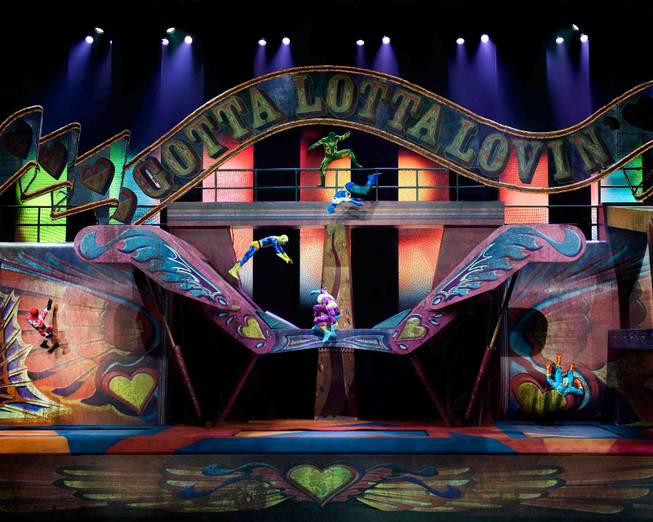
Julie Aucoin/Cirque du Soleil
Cirque du Soleil’s Viva Elvis at MGM CityCenter’s Aria.
Saturday, Feb. 20, 2010 | 10:43 a.m.
Viva Elvis Blue Carpet
Celebrities walk the blue carpet at Aria for the premiere of Viva Elvis.
There is a scene in "Viva Elvis" in which a couple dozen Cirque du Soleil dancers, hearkening to Elvis' Army years, gyrate under a backdrop of an American flag made of long underwear for stripes and boxers for stars.
You take note of the stars — or, in this case, the rows of stark-white boxers — and you count 48. That's because when Elvis joined the Army in 1958, Alaska and Hawaii were not yet states. So there was a production meeting at some point about this scene: "Make sure we have 48 pairs of white boxers, not 50, for the 'Gi Blues' scene." Cirque's attention to detail, even after rolling out seven productions on the Strip, has not waned.
There were other moments from Friday night's gala premier at Aria, particularly early, that merited explanation. And we're not only referring to the stoppage in the opening number, "Blue Suede Shoes," because a fire alarm had gone off in the theater. What was the connection between Elvis Presley and the costumed trampoline artists made to approximate superheroes? As a kid, Elvis loved comic books — fortunately the Colonel Tom Parker character tells us this before these boys get to bouncing. But even after you've been educated, you're wondering what is the point of all these costumed characters bounding around the stage other than to take a segment of Elvis' personality and expand upon it simply because costumed characters jumping on trampolines is a Cirque hallmark.
Flaming rope tricks, too, are used in the show at one point. This is during a number paying tribute to Elvis' profitable, joyful and (mostly) artistically languid film career. The ropes are set aflame and spun with great enthusiasm by Cirque characters in cowboy outfits. One draws a pistol and fires a shot into a campfire, which bursts into flames. It's terrific fun, but when we think of Elvis, is a cowpoke spinning a flaming lasso something that springs to mind? I mean, if someone is going to fire a gun, he might as well aim it at a television.
There is room in the show for these scenes, yet nothing to indicate the legendary bond between Elvis and the members of his Memphis Mafia inner circle, the sphere of friends who acted as his confidants, support staff, and security detail. I didn't detect any footage, even, of any of these guys, those who wore the gold Taking Care of Business "TCB" necklaces. There is representation of an Elvis impressionist, though, an oft-discussed topic during the run-up to the production. Would there be an Elvis impressionist? There is, kind of, portrayed by a guy in a massively oversized Elvis wig and shades, wearing a gold suit and whirling around the stage on skates during "Blue Suede Shoes." He replaces the Elvis on stilts that Priscilla Presley 86'd from the show during preview performances, and he doesn't last long in the show.
The production does present several moments when you're unconvinced about the strength of the link between what you're watching to the life and career of the King. Every live voice is that of a female; the only male voice heard is recorded Elvis. The Colonel Tom Parker character has been stripped of a folksy Southern accent after Priscilla sought to tone down the folksy dialect of early preview performances, including the scenes that played out for media members. It's a sensible move, but the character, portrayed by Garrett Eugene Case Jr., appears so infrequently you almost forget he's been charged with carrying the production's narrative.
"Hound Dog," at the end, is set amid a "Jubilee"-style, staircased set as video images of Elvis gyrating at the Hilton play out in the background. It helps you remember, or be introduced to, the real joy in Elvis' best music. Red scarves float from the ceiling as the show closes, even.
As fans filed out of Friday's performance, they were beaming. One told me, "I'd heard nothing except bad things about the show, so I'm pleasantly surprised." He wasn't alone. Advance word about the show was that it needed a lot of work, and based on that expectation, the show as a whole is plenty entertaining.
But we're left wondering what Presley himself would have thought of the Elvis Experience, 2010. Priscilla Presley repeatedly has said he would have been honored at the tribute, stressing that the show is intended to be a very Vegas-ized tribute to the King's legacy. I'm also remembering what one of Presley's oldest friends, Jerry Schilling, said back in December about what Elvis would have thought of being the subject of the Cirque treatment.
"This show has the potential of bringing Elvis to a whole new audience, a younger audience," said Schilling, who met Elvis when he was age 12 and Elvis 19 during a pickup football game in North Memphis and was a member of the Memphis Mafia until Presley died. "I think he would have no problem with the esoteric part of Cirque. As a friend, to be able to go to Vegas and see Elvis's name in lights again, is great."
Many I talked to at that time said Elvis would have been humbled at being so lauded by a creatively acclaimed company like Cirque. Schilling was impressed by a visit from 75 members of the “Viva Elvis” cast and crew to Graceland last year, topnotch professional entertainers who stayed for hours asking questions and poring over Elvis material in an effort to get this show right.
Even so, Elvis' longtime opening act at the International and Las Vegas Hilton, legendary comic Sammy Shore, was not particularly impressed with what he saw. "I liked the first trumpet player," he said afterward at the post-show party at Haze nightclub. As for the rest, he found it "impersonal." Yet for many in the Presley camp, the objective was to return Elvis to Las Vegas, give him his first Strip residency and dust off those old 45s. It's Elvis, it's Vegas, and it had to happen.
Follow John Katsilometes on Twitter at twitter.com/JohnnyKats.

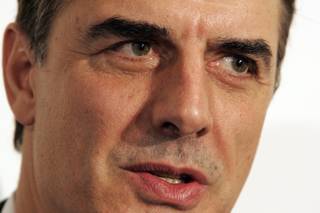
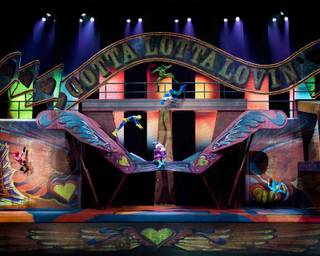
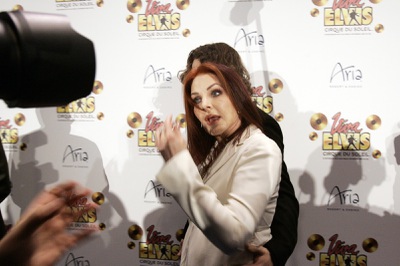
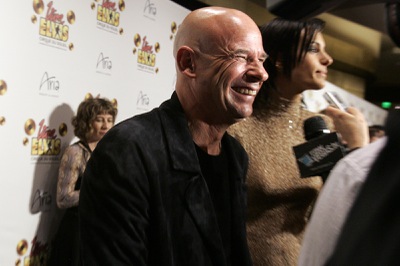

Join the Discussion:
Check this out for a full explanation of our conversion to the LiveFyre commenting system and instructions on how to sign up for an account.
Full comments policy